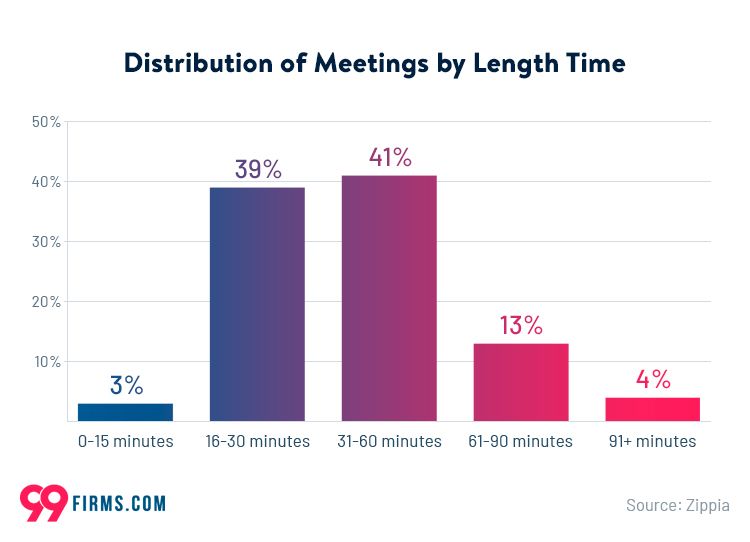Whether you love them or hate them, it’s likely that you’ve got at least a few scheduled this week. Office meetings are absolutely everywhere in the corporate world, allowing people to communicate and share information. However, there are also many drawbacks of office meetings, with unproductive sessions costing over 24 billion hours each year.
Workers spend a lot of time in meetings each week, time which they could alternatively spend working. The core frustrations with meetings aren’t the format itself, but when executives or managers host meetings only to waste time. The famous “this could have been an email” line comes to mind.
On average, an employee attends around eight meetings each week. Instead of only seeing the drawbacks of office meetings, we’re here to set the record straight. We’ll go through the main frustrations with meetings and provide actionable solutions that you can follow.
You’ll be hosting better meetings in no time. Let’s dive right in.
What are the potential drawbacks of office meetings?
The current state of meeting culture has gotten a little out of hand. 58% of employees report that their meetings last over 30 minutes on average, with this accounting for a huge amount of time that could have been productive working hours. While some meetings are absolutely necessary and can even save time, that isn’t the case for most of them.
Here are some of the most prominent drawbacks of office meetings:
- They can be unproductive – If a meeting doesn’t conclude with clear, actionable items for future work, new information for employees, or additional insight, it could have been a waste of time.
- Meetings go on for too long – Does your meeting really need to take 30 minutes? Could you have done it in 15; what about in 10?
- Meetings seem structureless – Without a clear structure, employees may feel that the host doesn’t know what they’re doing or why they’ve called people to the meeting.
- Routine meetings clog up working hours – If you have legacy team meetings doctored into schedules that don’t need to be there, you could be wasting people’s time.
When asked, most employees pinpoint these four areas as the main drawbacks of office meetings. Luckily, each one of them is something your team can remedy and overcome on the pathway to better meetings.
How to minimize the drawbacks of office meetings
In order to minimize the drawbacks of office meetings, we’ll methodically work through each of the biggest employee concerns, providing effective solutions you can put in place.
Let’s dive in.
How to overcome meetings that go on too long
Longer meetings can be a force of habit in a company. If certain people are used to running their meetings a particular way, they may frequently overshoot time limits. Trust us when we say, nobody wants to be in a meeting that overruns. In fact, meetings that go on too long can even cause people to fall asleep, with nearly 40% of employees having dozed off in a meeting.
In order to keep your meetings as short as possible, focus on clear goals throughout the meeting. What do you want to have covered by each 5-minute interval? If you don’t clearly know what you should be hitting every 5 minutes, you need to create a better meeting structure, which we’ll discuss shortly.
Always focus on speeding through meetings as quickly as possible; everyone will thank you. If absolutely necessary, you can send around preliminary information so everyone is already up to speed, allowing you to get to the meat of the problem even quicker.

How to give meetings more structure and boost productivity
Creating a meeting agenda is one of the most effective ways of structuring a meeting. Send around an agenda before your meeting that details what the meeting is about, why it is happening, and what your action items will be afterward. Meeting agendas are one of the most powerful tools that you can have in your meeting arsenal.
What’s more, you’ll be able to include additional information in your agenda, like the studies or reviews that you’ll be talking about. This approach ensures that when you arrive at a meeting, everyone will already know what’s going on, helping to streamline conversations and focus on creating a productive meeting space.
Another great way to give extra structure is by designating a specific room or collaborative office phone booth to have the meeting in. Having an external space where everyone assembles ensures people arrive on time so you can get started. Treat meetings as an in-and-out operation, reduce time where you can, and stick to your agenda above all else.
How to rework routine meeting schedules
If you’re looking to overcome one of the main drawbacks of office meetings, take a look at any employee’s typical work calendar. If you notice a high number of routine meetings, begin to question why. Certain teams, like software development teams using Agile, will absolutely need a morning meeting, but your marketing team might not.
Find out which meetings are necessary and which occur only because that’s how that team has always done things. You can always poll specific departments to find out if any of their meetings seem like a waste of time. Cut back on meetings where you can.
Final Thoughts
Office meetings don’t have to be a total waste of time. In fact, there are a lot of benefits to office meetings that your team can take advantage of – if you run meetings correctly. By focusing on the main drawbacks of office meetings, we’re able to tackle them one by one and create effective solutions to improve meeting culture.
By following the four strategies that we’ve outlined in this list, you’ll be able to create meetings that engage your employees without taking up too much time. Not only will your employees be happier to come to meetings, but you’ll all walk away with the information you need to succeed in your day-to-day roles.

